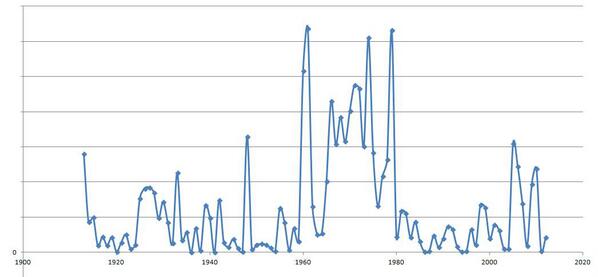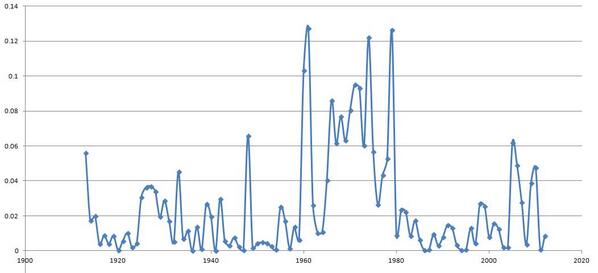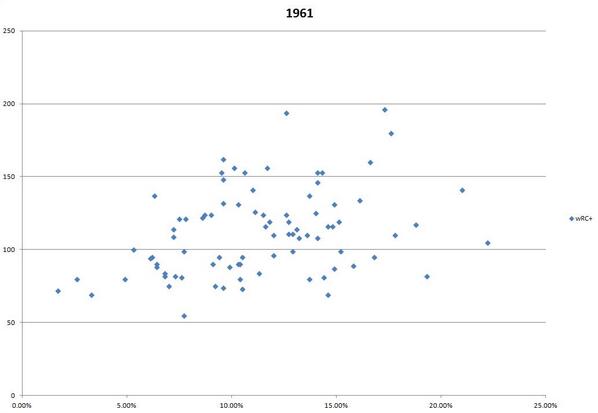Of course, the concept of “stuff” is very subjective, and my formula is not so much of an attempt to quantify a subjective concept as it is an attempt to measure how well pitchers do things we associate with great stuff. Because I used Pitch f/x data exclusively, the ratings were limited to pitchers from 2007 to the present.
My formula is ((4*O-Zone Swing% *O-Zone Whiff%)+(3*Whiff%)+(5*Zone-Whiff%)+(2*IFFB%)*(FBv/100)*(4))
I will probably tinker with the formula, and will welcome any suggestions with regards to improving it. I have only applied it to starting pitchers. Of course it can be applied to relievers, but their scores run much higher unless some kind of a “relief penalty” is applied. The STUFF ratings for all starting pitches who threw at least 160 innings since 2007 run between 3.4 and 9.7. The following list presents the top 15 career STUFF pitchers since 2007.
1. Rich Harden 9.7. If you’re having trouble remembering just how filthy Harden could be, visit his player page. Harden got swings and misses like no other starter. In 2008 he had an unearthly 48 ERA- and 68 xFIP- despite the fact that injuries had already started to take their toll on his fastball velocity, as it dropped to 91.7, compared to 94.1 the year before. In 141 innings in 2009, he got whiffs on 22.6% of swings on pitches in the zone. Max Scherzer, the 2013 leader in that category, gets whiffs in the zone at an 18.4% clip. When Aroldis Chapman averaged 100 mph on his fastball in 2010, he sat at 21.9%. Unfortunately, a litany of injuries would decimate Harden’s career, and he was recently released by the Twins, an organization known for their disdain for swing and miss stuff.
2. Matt Harvey 9.4. The young right-hander with the dynamic fastball places near the top in all five of the STUFF factors, with only Scherzer, Harden, and Escobar topping his 17.6 Zone-Whiff%. Besides the fastball, Harvey also features a slider, curveball, and changeup. Harvey’s plethora of filthy offerings produces whiffs on over a quarter of his pitches overall. Furthermore, Harvey is one of the rare pitchers who has actually experienced an increase in fastball velocity since his debut season.
3. Yu Darvish 9.2. Darvish uses his assortment of pitches to produce whiffs on over half of swings at pitches he throws outside of the zone, easily the best in the sample. Combine that with a whiff rate of 15.9% for swings on pitches in the zone and you get an overall whiff rate of 28.6%, also the best in the sample. Pitch f/x credits Darvish with six different pitches, four of which he throws at least 12 percent of the time. Though Darvish averages 92.9 mph on his fastball, he has thrown his slider nearly as often as his four-seamer and two-seamer combined. The unconventional approach has produced five games of 14+ strikeouts in 2013.
4. Kelvim Escobar 8.9. Escobar only had one year of data, but what a year it was. At the age of 31, Escobar’s fastball velocity surged to 94.1, higher than any of the pre-pitch f/x years, and he utilized an excellent changeup to get whiffs on over a third of swings at pitches he threw outside of the zone and a quarter of swings overall. However, in spring training of 2008, Escobar was diagnosed with a shoulder injury that required surgery and except for a 5 inning stint in 2009, he never returned to the majors.
5. Michael Pineda 8.7. Like Escobar, Pineda only has one year of data in the sample due to shoulder surgery. Elite fastball velocity combined with a slider that helped generate swings on a third of the pitches he throws out of the zone and contact on less than sixty percent of those swings earns him this ranking. The big righty also used his height to get one of the highest infield fly rates in the sample. Pineda was placed on the DL shortly after an August 2 rehab start resulted in stiffness in his shoulder, and it appears unlikely that the righthander will pitch again in 2013.
6. Matt Moore 8.6.While Moore’s fastball velocity has dipped steadily since he came into the league in 2011, its overall average is still 93.6. Moore’s ranking is based heavily on his 2012 STUFF rating of 9.3, his 2013 rating has fallen to 7.4. Moore has battled elbow soreness this year, and hopefully this will not be a long-term issue and he can return to the form that generated a dominant 19.0 Zone-Whiff% in 2012.
7. Francisco Liriano 8.6. Liriano’s slider has long been one of the best pitches in the game, and only Darvish can top his whiff rate on pitches outside the zone. Since joining the Pirates, Liriano has been using the slider even more, throwing it on 37.1% of his pitches. Liriano is also throwing his changeup more than he ever has before. While his 13.1 Zone-Whiff% in 2013 is one of the lowest numbers of his career, the offspeed pitches have resulted in a 36.1% chase rate, the highest of his career. It’s anyone’s guess as to how long Liriano’s oft-troubled elbow holds up, but Pirates fans should enjoy the ride while it does.
8. Cole Hamels 8.5. A master of deception, Hamels’ changeup has helped him produce a career whiff-rate of 24.5%. Among pitchers on this list, Hamels 90.9 mph fastball is faster than only fellow changeup artist Johan Santana. However, the 8-9 mph difference between his fastball and changeup produces a 33.8 chase rate, the 5th highest in the sample, and his 37.0 rate in 2013 leads the majors. Hamels has also been very durable, among the top 15 STUFF pitchers, only Justin Verlander has thrown more innings.
9. Stephen Strasburg 8.5. While Strasburg’s fastball velocity has fallen from its pre-Tommy John high of 97.6, his 95.9 average is still tops Felipe Paulino, the next closest in the sample by 0.7 mph. While we will probably not see the pure electricity of the pre-injury Strasburg which produced a 9.5 STUFF rating in 2010, Strasburg still gets whiffs on over 15% of swings on pitches in the zone and 25% overall. If the Nationals’ controversial innings-management plan pays dividends and the 25 year-old can stay healthy, he should be getting whiffs for years to come.
10. Max Scherzer 8.3. It seems fitting that a noted sabermetrician would obtain a high ranking on a list based on Pitch f/x and batted-ball data. To the misfortune of AL hitters, Scherzer has vastly improved his secondary pitches while maintaining his fastball velocity. Before his trade to the Tigers, Scherzer threw his fastball over two-thirds of the time. With the Tigers, Scherzer’s fastball usage has decreased each year, and his use of secondary pitches, particularly his changeup, has increased. Not surprisingly, this has resulted in higher chase and whiff rates, and his Zone-Whiff% of 19.9 since 2012 leads the majors.
11. Clayton Kershaw 8.1. Kershaw burst onto the scene in 2008 as a 20 year-old rookie with a 94 mph fastball and 73 mph 12-6 curveball. Since then he has added a slider to make life even more miserable for hitters. Kershaw ranks near the top in all five of the STUFF factors. Kershaw appears to be the odd bird that can use his pitch arsenal as much to suppress BABIP as to generate swings and misses, and this factor probably keeps him from being ranked even higher.
12. Tim Lincecum 8.0. You would be hard-pressed to find a smaller starting pitcher than Lincecum. While that height limits his ability to get infield flies, the dynamic changeup more than compensates for his lack of size. Of the top 15 pitchers, only Darvish and Liriano have higher whiff rates on swings at pitches out of the zone. Lincecum’s fastball velocity has steadily dropped from its high of 94.0 in 2008 to 90.2 in 2013. Since 2011, Lincecum has been throwing a slider more often, and while he has been prone to the longball, he still gets whiffs on a quarter of swings. While Lincecum is no longer the pitcher that won CY Young awards in 2008 and 2009, he is a very intriguing free agent, and at the least, it seems that he could be a dominant reliever.
13. Chris Sale 8.0. The lanky, or perhaps paper-thin lefthander has made a successful transition from the bullpen to the rotation. After experiencing a predictable velocity drop from the move, Sale has actually regained some of that velocity this year, as his fastball has jumped from 91.3 to 92.4. Since moving to the rotation, Sale has added a changeup to go along with his excellent slider. Sale’s herky-jerky sidearm delivery and late movement have helped him generate a 32% chase rate, 5th best among pitchers on this list. While concern’s about Sale’s elbow and durability are certain to persist, Sale is on pace for over 200 innings this year after throwing 192 last year.
14. Johan Santana 7.9. Shoulder troubles robbed Santana of some of his fastball velocity, and his average of 90.3 is the slowest among pitchers in the top 15. However, his changeup was devastating. In its heyday in 2007, Santana had a Zone-Whiff rate of 23.2%. While some of Santana’s best years were in the pre-Pitch f/x era, the Mets still got highlights such as a 36.0 chase rate in 2009, and the no-hitter in 2012. Santana’s changeup also had the effect of suppressing BABIP, as noted by a .276 career mark. Of the top 15, only youngsters Harvey and Moore can top Santana’s 12.9 IFFB%.
15. Justin Verlander 7.9. It took Verlander a couple of years to fine-tune the curveball, but when he did, he started churning out elite swing-and-miss rates. Since 2012, Verlander has been utilizing the changeup more than the curveball, and it too has produced excellent whiff rates. The secondary offerings go along with an average fastball velocity of 94.8 that only the less battle-tested Stephen Strasburg, Matt Harvey, and Felipe Paulino can top. Since 2007, Verlander has thrown over a 100 more innings than Cole Hamels, the next closest person on this list.
Clearly, the list favors younger, less tested pitchers. But I don’t think there’s anything wrong with that. As pitchers age, their velocity declines, and while Felix Hernandez is a better pitcher throwing 92 then when he was a young flamethrower, he probably doesn’t create the same kind of excitement in fans or fear in hitters when he averaged 96 with his fastball.
I also made a list of the worst 15 starting pitchers by STUFF since 2007. I didn’t think it would be worth anyone’s while to go through the list, but suffice it to say that the worst three were Steve Trachsel, Sidney Ponson, and Livan Hernandez. Yeah, I’d say that sounds about right. Aaron Cook of the 1.9 K/9 in 2012 also made the list. The following table is a comparison of the best and worst 15 starting pitchers since 2007 by STUFF rating.
| |
BABIP |
LOB% |
xFIP- |
ERA- |
| Best 15 |
0.284 |
75 |
85 |
82 |
| Worst 15 |
0.304 |
74 |
107 |
112 |
So the best STUFF pitchers seem to have an ability to limit hits on balls in play and overachieve their peripheral stats, while the worst STUFF pitchers allow hits at slightly above the league average and underachieve their peripherals. Some of this is due to infield flies, which was a factor in the STUFF formula. The best 15 had an IFFB% of 11.0, while the worst 15 had an IFFB% of 7.4. But there are other factors involved. Tim Lincecum has a 7.4 IFFB% and a .296 BABIP while Nick Blackburn has a 8.6 IFFB% and a .309 BABIP while the BABIP of their respective teams since 2007 is .297 and .300. Both of these pitchers are well past the stabilization point for BABIP. So it seems that pitchers with dominant STUFF have some control over hits on balls in play outside of IFFB. Of course I cherrypicked an example, and I’m sure there are counterexamples, but the general idea seems good. Great STUFF can have an effect beyond generating swings and misses.




